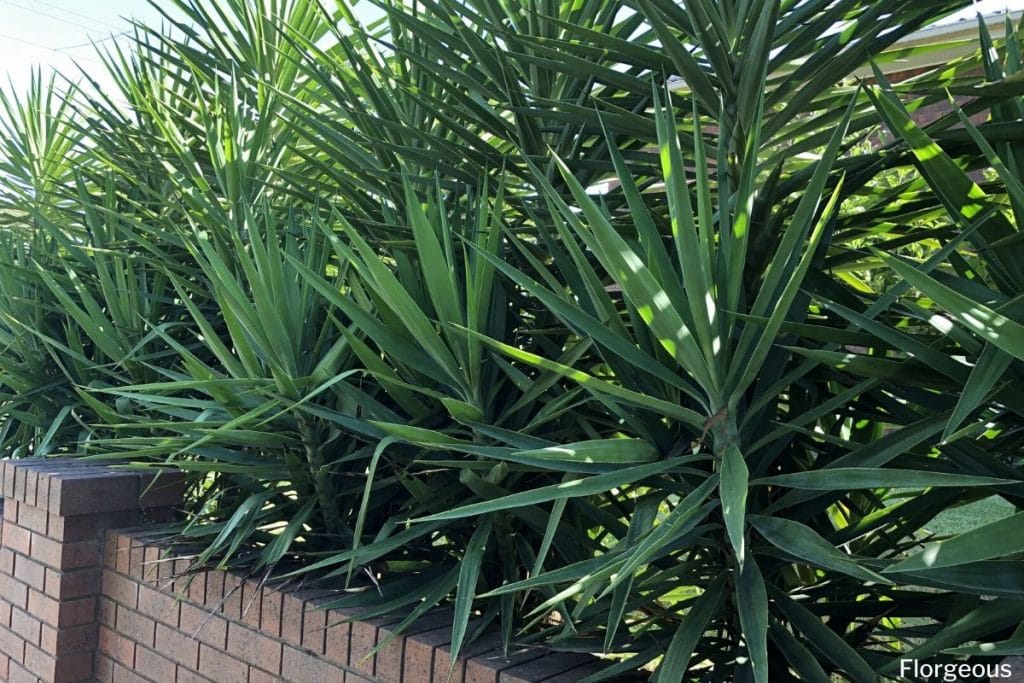Yucca plants are popular all over the world, prized for their adaptability both indoors and outside. Native to hot, arid environments like the Carribean, the American Southwest, and South America, yuccas are incredibly diverse.
However, there are many types of yucca plants to choose from. Whether you’re an inexperienced gardener with no idea where to start – or you’ve been in the hobby for quite some time – the vast quantity can be downright overwhelming.
If you’re interested in learning more about yucca plant care guides, as well as which types of yuccas will be right for you – you’ve come to the right place.
We’ll tell you everything you need to know about these amazing drought tolerant plants.
How Many Different Types of Yucca Plants Are There?
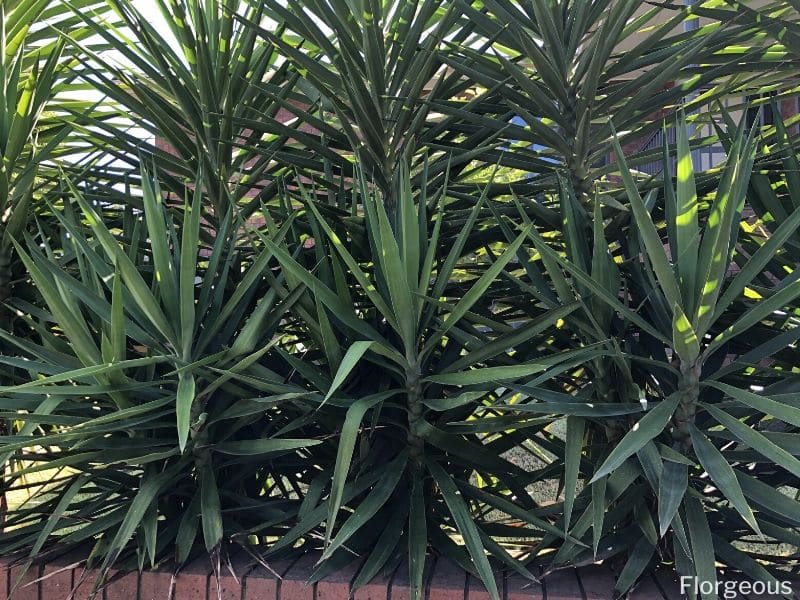
The answer to this question depends on where you look! Found in zones 5 to 11 in the United States, the exact distribution of yucca varies depending on the type.
In the United States, there are at least 27 recognized types of yucca plants. These are more widely distributed than the other common heat-loving plants of the south, agave, with yucca plants spread all around the Midwest, the Great Plains, and even numerous eastern and southern states.
Worldwide, there are somewhere between 40 and 50 types of yucca (to be even more precise, botanists believe that there are 49 recognized species and 24 recognized subspecies of yucca within the Americas).
Although early varieties of yucca plants were originally confused with the cassava, they eventually earned their own recognition and are now widely recognized as some of the best garden plants.
What Exactly Are Yucca Plants?
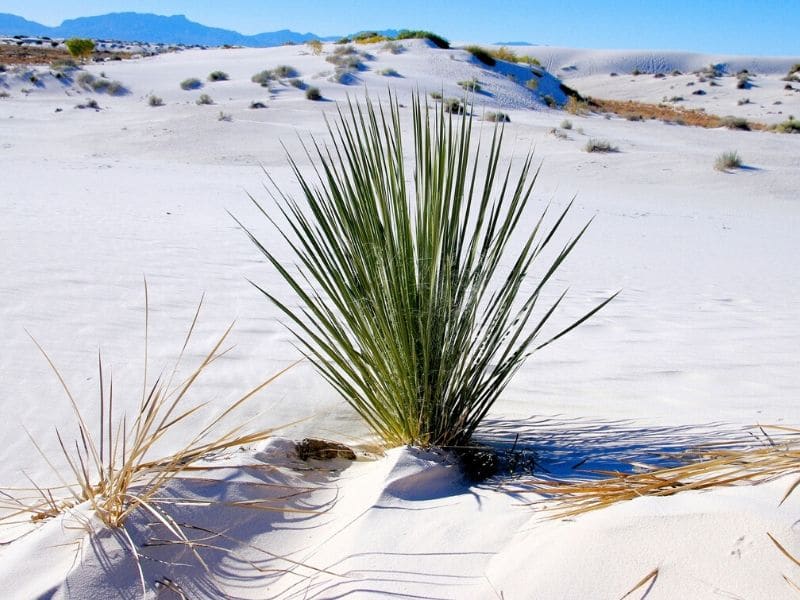
With large, spiky leaves and gorgeous clusters of enormous white flowers, yucca plants are ideal in a landscaping setting. Each one has its own unique architectural shape and can serve as a striking accompaniment to your other garden plants.
Yuccas are characterized by their dense, closely-formed rosettes that contain multiple thin, closely-spaced leaves. These are often edged by white, curly hairs. Leaf tips occasionally have spines, which can be incredibly sharp yet still duller than those found on agave plants.
A mature yucca plant can grow as tall as 30 feet and as wide as 25 feet with their various offsets. Smaller yucca types will only be about two to four feet tall and wide. There is a great deal of variation between the many yucca plants.
There are slight variations between all the different yucca varieties, but all have the ability to grow tall and to branch out. However, in some super dry locations, yucca plants will remain compact in order to conserve energy.
Most yuccas produce white, bell-shaped flowers that gather in a large mass on a short stalk. Flowers are usually produced once each year.
Yucca trees grow slowly, storing water in their bulbous bases or their dense trunks. They are incredibly drought-tolerant and need very little maintenance to survive. As a result, a yucca plant is a top contender in a natural garden in the south.
Just keep in mind that the toughness of the yucca cane can be a bit of a drawback – some gardeners have difficulty removing them once their roots have become established!
Common Varieties of Yucca Plants
Banana
The banana yucca, or Yucca baccata, is native to the American Southwest and requires very little water. It’s well adapted to dry conditions and also can handle neglect with ease. This low-maintenance yucca has spiky leaves with the ability to reach two to three feet (sometimes even a bit more!).
However, this is not the yucca plant to grow if you have an impatient green thumb. It can take several years for the banana yucca to bloom, and when it does, it often dies shortly after.
Bright Star
Found in zones 7 through 11, Yucca Gloriosa ‘Bright Star’ only grows to about one or two feet tall. It has yellow and green striped leaves, along with flower stalks that produce pink buds.
It’s one of the best types of yucca plants for northern gardeners, as it is hardy down to 0 degrees Fahrenheit.
Spineless
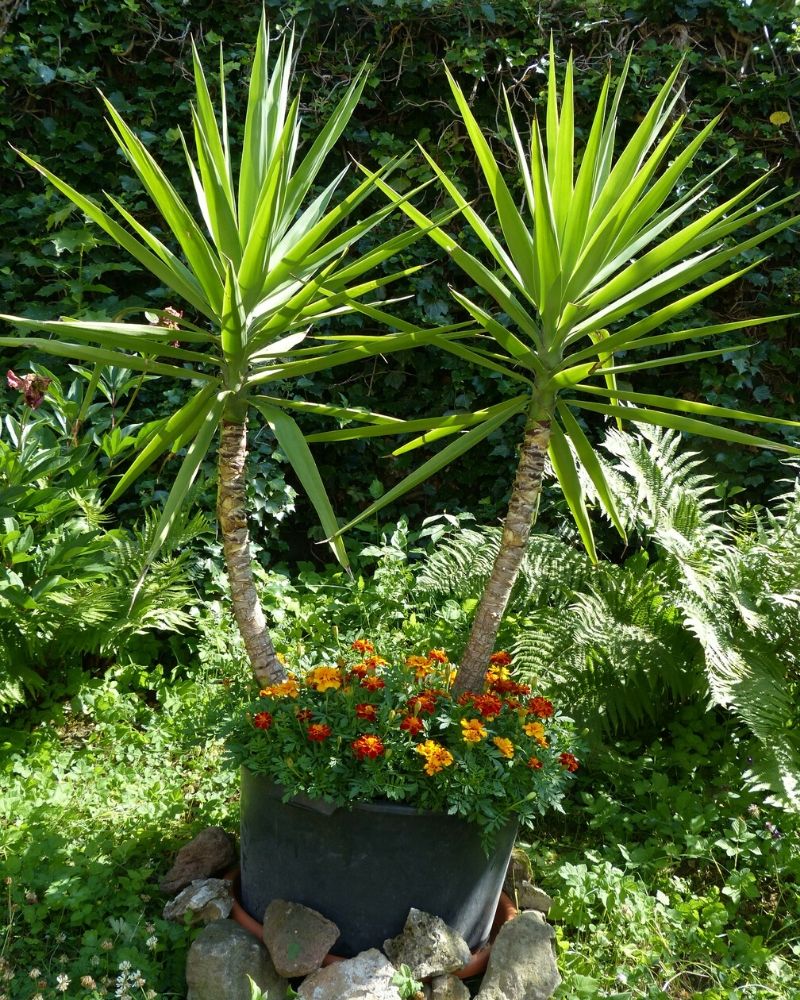
Spineless yucca is a yucca of many names, including giant yucca and, more formally, Yucca elephantipes. This yucca is native to zones 9 to 11 and can grow up to 25 feet tall when grown outdoors.
When grown inside, it will maintain a more moderate growth of just 10 feet tall. It has luxurious, verdant green foliage with white flowers, and its soft leaves make it ideal for indoor gardeners.
Beaked Yucca Plant
Also referred to as big bend yucca or Yucca rostrata, beaked yucca has one trunk and a highly recognizable pom-pom that’s topped with sharp blue leaves.
When it’s fully blossomed, the beaked yucca plant has orange or yellow flowers. It’s often used in gravel and Mediterranean gardens, where it’s regarded as one of the most attractive types of yucca.
Thompson’s Yucca Plant
Yucca thompsoniana or Thompson’s yucca has a single trunk, so it’s often confused for a beaked yucca plant. However, the main difference between the two is that Thompson’s yucca plant can have two trunks instead of just one.
It also has pom-pom shaped foliage, but its overall growth will be much slower and smaller than that of the beaked yucca. In fact, Thompson’s yucca will only grow to about six feet tall.
Red Yucca
The red yucca plant (Hesperaloe parviflora) is native to Central America and is the perfect choice for an outdoor ornamental garden. With striking colors, it can create a vivid aesthetic in your garden.
It produces pink flowers atop tall, skinny spikes. It grows like a weed and is remarkably drought-tolerant, blooming year-round as long as you provide it with plenty of sunlight.
When choosing red yucca companion plants, they need to be able to thrive in hot and sunny regions.
Yellow
The yellow yucca plant is closely related to the red yucca plant. Also native to southwestern America, it can actually be planted side by side the red yucca for a showstopping, bi-colored appearance.
It produces large, trumpet-like yellow flowers that can each produce growth up to five feet long. This yucca plant is also prized for its ability to attract hummingbirds, and it blooms well into the fall.
Joshua Tree
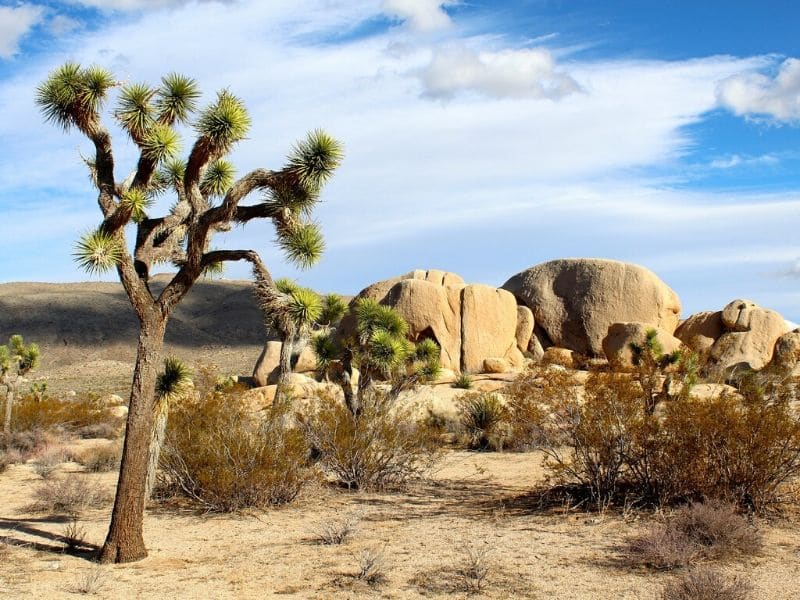
Yucca brevifolia is commonly known as the Joshua tree. Growing up to 40 feet tall, it is one of the fastest- and tallest-growing yucca species. It is found in zones 6 through 10 and blooms in the spring (but unfortunately, it does not bloom every year).
It’s the iconic symbol of the Mojave Desert and perhaps the most famous type of yucca plants – after all, there is a national park named after it!
Soapweed
Soapweed yucca, or Yucca glauca, is another Southwestern type of yucca plant. It has flower spikes that are three- to four- feet long, each completely packed with enormous white flowers.
It is another cultivar that thrives on neglect, doing well as long as it has ample amounts of sunlight.
Beargrass
Yucca smalliana, the beargrass yucca, is native to the southeastern portion of the United States. Its major allure has to do with the fact that its leaves are much softer (and less prickly) than what you may have experienced in other yucca plants.
As a result, these plants are more than safe to plant around small children or other visitors. They also produce luxurious flowers that smell delightful when in bloom.
Spanish Bayonet
Spanish bayonet, also known as Spanish dagger, by contrast to Beargrass Yucca, needs to be kept far away from walkways and other high-traffic areas.
Though beautiful to look at, the Spanish bayonet yucca, or Yucca aloifolia, produces sharply-pointed spikes that are densely packed and of varying heights. You’ll enjoy dense, aromatic flower clusters, but the spikes can be so hazardous you’ll want to think carefully about where you grow this yucca.
Adam’s Needle
Adam’s needle, or Yucca filamentosa, produces long, pointed leaves that are about two and a half feet long. They are unique, however, because they rise directly from the ground. When the plant is mature, it will send up a towering six-foot flower stalk that holds countless bell-shaped flowers.
These flowers aren’t just beautiful to look at – they are also heavily scented and will attract hordes of pollinators to your yard. Unfortunately, like Spanish bayonet, Adam’s needle also needs to be planted well out of the way of high-traffic areas.
Where Are The Different Kinds of Yucca Plants Found?
It’s important that you have a clear understanding of the exact type of yucca plant you are growing. While southwestern yuccas prefer dry, sandy soil and plenty of sunlight, those native to the southeast can tolerate more humid conditions. It makes sense, right?
Unlike agave, yucca isn’t resigned to a certain ecosystem. In fact, you will find various types of yucca plants in mixed environments of all kinds, including coastal scrub, mountain grassland, and even the desert!
Yucca plants extend beyond the borders of the United States, too. There are varieties found in Central America and Mexico and even some that have been transported overseas (although they are not native to these areas).
The natural range is believed to cover a vast area of the Americas, going from Guatemala upwards into Baja California and even as far north as some regions of southern Alberta, in Canada.
There are also some yucca plants that are native to the Caribbean Islands as well as the coastal areas of the southeastern United States, such as those along the Gulf of Mexico. They are easily adapted to a wide range of ecological conditions.
What Are Yucca Plants Used For?
Think carefully about how you intend to use your yucca plant before you decide on the right type of yucca plant for you. Many plants have a number of uses!
Most yucca plants are grown for ornamental interest, but you don’t have to resign them strictly to the outdoor growing space.
It’s also common to see yucca plants thrive as houseplants! If your climate is too harsh to grow yucca plants outside, growing yucca plants indoor is a fantastic alternative as long as you have the right potting soil and watering schedule.
In addition, many types of yucca plants also produce fruits and flowers that are not only edible but delicious. Two to consider include the soapweed yucca and the banana yucca.
The benefits of eating yucca extend beyond a tasty meal and a full belly, however. Some yucca roots and leaves contain anti-inflammatory substances known as steroidal saponins. This herbal remedy can help relieve symptoms of arthritis, and it may also help to cleanse the kidneys, heart, and blood.
You can even use some types of yucca plants – namely, soapweed yucca – to make cosmetic and personal care products. Soapweed yucca is often used to make soaps and shampoos. In some cases, yucca has even been woven into baskets or been a key ingredient in fiber that can be twisted into rope.
There are even some types of yucca that can be used as fire starters!
Incidentally, yucca plants can also be used to boost the health of your local ecosystem. Yucca plants are deer resistant, but they aren’t repulsive to other creatures. In fact, yucca flowers emit a fragrance each night that attracts the aptly-named yucca moth. These moths are important for the plant’s survival, as they are its only pollinator. In return, yucca plants serve as host plants for the moths.
When grown indoors, yucca plants are excellent air purifiers. Their roots can be used for medicinal purposes, and more than anything else, yucca indoor plants have the ability to offer unrivaled beauty to both the interior and exterior of your home.
How to Grow and Care For Outdoor Yucca Plants
If your climate permits it, growing a yucca plant outdoors is by far the best option for you. These plants are low-maintenance and often, when fussed over too often in an indoor garden, will succumb to common problems like overwatering or a lack of good airflow.
To plant yucca outside, find a spot that offers full sun exposure. Too little sunlight can cause decreased flowering and spindly foliage development. The best time to plant is in the spring – this is also when your plant will begin blooming (although this varies depending on the plant).
When planting outdoors, wait until temperatures are a minimum of 55 to 65 degrees – for plants that are more sensitive to the cold, add another ten degrees to this minimum before you plant.
Your yucca plant will also require well-draining soil. Yucca plants develop root rot easily if they become waterlogged.
Wherever you plant, keep the characteristics of your chosen type of yucca in mind. Yuccas have sharp spines – some varieties have sharper needles than others – so you will want to keep these out of the reach of children and pets. Some are also toxic to dogs, cats, and humans. You also need to consider the final potential size of your yucca plant – some develop massive root structures that can damage foundations and invade irrigation pipes.
The night before you plant, soak your seeds for 24 hours. This will help with germination. Then, plant your seed at a depth of two seed lengths. Make sure the seeds remain moderately moist, and you’ll notice germination within just four weeks.
Once the seedlings emerge, try to exercise patience. It can take some time for your yucca plant to put on good growth! Since you will only need to water about an inch per week, you may find yourself bored with the lack of tasks that you need to do in order to maintain the growth of your yucca plant.
Pruning a yucca plant is not necessary, but you can if you want to remove any dead or damaged leaves. If you prune, do so in the spring and only remove what you absolutely need to. Fertilizer is not necessary, either, but it can help boost growth when applied in the early spring and summer months.
Why Should You Grow Yucca Plant?
There are so many types of yucca plants to choose from. While smaller variants make excellent container plants, cold-hardy plants are the perfect choice for northern climates. They are easy to care for and require minimal watering and other maintenance.
An excellent choice for a rugged or drought-tolerant garden, the yucca plant is a fantastic option for a beginner gardener – as long as you are willing to be patient while it gets itself established!
FAQs
How often do you water a yucca plant?
Yucca plants are drought-tolerant and should be watered sparingly. Allow the soil to dry out between waterings to prevent overwatering, which can lead to root rot.
Why is my yucca plant dying?
Yucca plants may decline due to factors like overwatering, poor soil drainage, insufficient sunlight, or pests. Ensure well-draining soil, provide adequate sunlight, and adjust watering practices to address the specific needs of your yucca.
Do yucca plants like heat?
Yucca plants are well-adapted to hot and arid conditions, making them suitable for warm climates. They generally thrive in heat and can withstand high temperatures.
Up Next: Succulent Plants for Your Indoor and Outdoor Gardens

